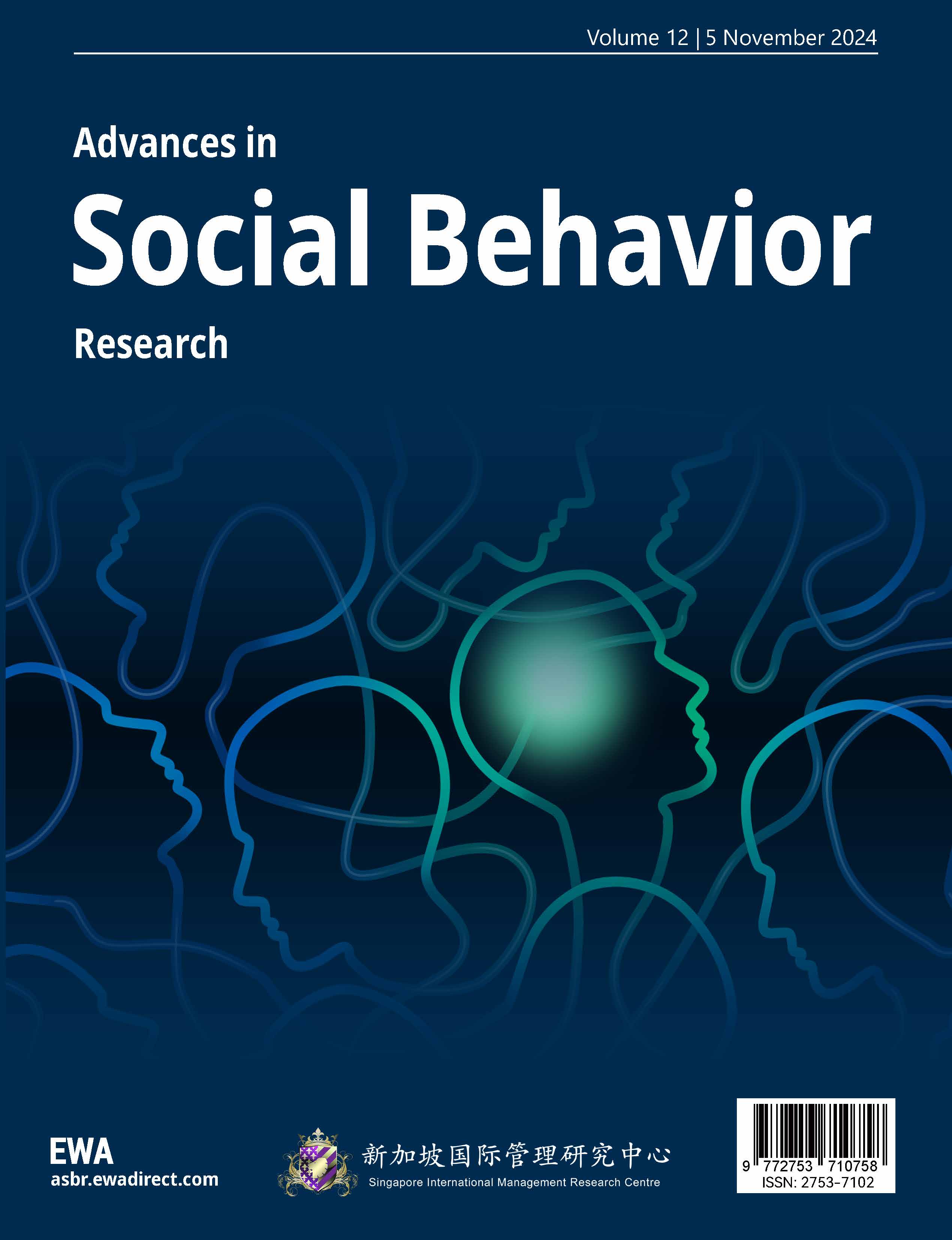1. Introduction
Since the mid-20th century, the recorded number and prevalence of autism cases globally have shown a generally increasing trend year by year. Autism has become the leading cause of mental disability among children in China [1], yet its pathogenic causes remain unknown, and effective pharmacological treatments are lacking. Previous research has primarily focused on investigating the causes of autism and developing diagnostic methods, proposing etiological factors such as genetic influences and diagnostic schemes for different populations. However, research on autism treatment is relatively scarce, and studies specifically addressing how to provide services and guidance for autistic individuals are even rarer [2-4]. Therefore, to provide more scientifically sound assistance to autistic children through "treatment" targeting various aspects with different weights, this study takes the social cognitive characteristics of autistic children as its starting point and sets the improvement of interpersonal skills as the "treatment" goal. The rationale for this choice and the research process will be explained below.
2. Problem analysis
As a member of the Morning Star Club, an autism care club, we observed during volunteer activities that autistic children often exhibit social impairments. Deficits in social abilities are one of the primary symptoms of autism and a key factor in directly diagnosing Autism Spectrum Disorder [5]. Autism Spectrum Disorder is a syndrome primarily defined in behavioral terms (including social impairments, delayed language development, restricted interests, repetitive/stereotyped behaviors, and often below-average intelligence) but is generally associated with varying degrees of cognitive deficits. Understanding the cognitive processes in autism is a prerequisite for a comprehensive understanding of how this syndrome develops and is essential for designing effective strategies to ameliorate these cognitive deficits [6]. Consequently, we investigated and quantified the cognitive characteristics (including attention process, cognitive representation process, behavior generation process, motivation process, motivation) [7-10] and interpersonal skills (including response to calls, verbal expression, facial expressions and body language, social interaction, emotional expression and regulation, establishing and maintaining friendships) of 73 autistic children, and explored the associations between various cognitive characteristics and social skills [11]. By identifying the most influential cognitive characteristics, we aim to formulate strategies to improve cognitive deficits, thereby effectively enhancing the social skills of autistic children.
3. Basic assumptions
(1) The surveyed cognitive and social status of autistic children is relatively stable over a period of time. Autism is a neurodevelopmental disorder; its core symptoms are typically persistent and do not change significantly in the short term. The cognitive and social abilities of autistic children tend to be relatively stable.
(2) The surveyed autistic children exhibit significant characteristics primarily related to Autism Spectrum Disorder, with no other significant mental disabilities or minimal impact. Autism is generally considered a distinct diagnosis; its core symptoms are concentrated in social communication, behavioral patterns, etc., and are not accompanied by other severe mental illnesses. This assumption simplifies the characteristics of autism.
(3) Survey data is filled out truthfully. The research must be based on authentic and reliable data; otherwise, subsequent analysis and conclusions will be problematic.
(4) The survey data is representative. Only with a representative sample can the research findings be generalized to the entire population of autistic children. This is a prerequisite for the validity of the study.
(5) Autistic children exhibit homogeneity. Compared to other neurodevelopmental disorders, autistic children do exhibit a degree of homogeneity in certain core symptoms, which can simplify research design and analysis.
(6) The social skills of autistic children are primarily influenced by individual cognition; the influence of family, society, and other environmental factors is not considered. While environmental factors do influence the development of social skills in autistic children, individual cognitive abilities are likely the most critical influencing factor. Focusing on individual cognitive factors benefits the research emphasis.
4. Symbol conventions
This section defines key mathematical notations used throughout the study to ensure clarity and consistency in model formulations. Symbols are categorized by their primary context of use.
(1) General variables
1.
2.
3.
(2) Neural network model
4.
5.
6.
7.
(3) Multiple linear regression model
8.
9.
10.
(4) Grey relational analysis model
11.
12.
13.
14.
5. Data collection
Prior to model building, group members distributed questionnaires to autism support organizations and collected data from 73 autistic individuals, quantifying their social characteristics. The questions in the distributed questionnaire are listed below:
We quantified items from the questionnaire to derive the corresponding cognitive characteristics: attention process, cognitive representation process, behavior generation process, motivation process, motivation. For items 8-13, the group calculated the autistic individuals' social skill score by taking the average. Cognitive characteristics were used as model inputs, and the social skill score as the model output, written into the dataset.
6. Model establishment
The purpose of model establishment in this study is: To predict the social skills of the autistic population based on their cognitive characteristics, and to provide new insights for improving the social skills of autistic individuals by exploring the relationship between the two.
6.1. Neural network model
The research problem involves the relationship between the social characteristics of the autistic population and their social skill scores. Since the model involves autism and no quantitative relationship between variables can be currently established, questionnaires were distributed, and machine learning was used to explore variable relationships and predict the social skill scores of autistic individuals.
This study employs a neural network machine learning method to predict the relationship between the cognitive characteristics of autistic individuals and their interpersonal skill scores.
6.1.1. Dataset creation
We use the Dataset:
Where
Satisfying,
6.1.2. Building the neural network
Python code was used to build a neural network with the architecture
Where activation weights
Hidden Layer 2 also consists of 16 neurons:
Where activation weights
The output layer consists of one neuron outputting the predicted value:
Where activation weights
During our experimentation, we found that changing the activation function to sigmoid or tanh increased MAE and MSE by 5 and 15, respectively.
Therefore, the ReLU function was used for both hidden layers:
6.1.3. Setting hyperparameters and setting loss function
Learning Rate: Fixed at 0.1 for training epochs ≤ 5. For training epochs > 5, the learning rate decreases exponentially based on the number of epochs:
Mean Squared Error (MSE) was used as the loss function for model training.
6.1.4. Training the model
The model takes the feature vector as input and the interpersonal skill score as output. Model parameters (activation weights
6.1.5. Model evaluation
Mean Squared Error (MSE) and Mean Absolute Error (MAE) were used to evaluate model performance:
6.1.6. Visualization
Line charts were used to visualize changes in MSE and MAE during training. Scatter plots
6.1.7. Calculating coefficient of determination R2
Where
After predicting the relationship between autistic cognitive characteristics and interpersonal skills using the neural network, we employed Multiple Linear Regression and Grey Relational Analysis models to explore the associations between individual cognitive characteristics and interpersonal skills.
6.2. Multiple linear regression model
We used a multiple linear regression model to study the linear relationship between the cognitive characteristics of the autistic population (attention process, cognitive representation process, behavior generation process, motivation process, motivation) as independent variables
6.2.1. Mathematical model
Based on the fundamental assumptions of linear regression, assuming a linear relationship between and
Where:
1.
2.
3.
4.
5.
6.2.2. Model training and model evaluation
The dataset was split into training and test sets. The linear regression model was fitted using the training set, i.e., solving for the parameters β that best fit the training data.
After training, the model's performance was evaluated using the test set. Metrics such as Mean Squared Error (MSE), Coefficient of Determination (
A scatter plot of actual values vs. predicted values was created to visualize model performance. Ideally, points should cluster around a line with slope =1, indicating agreement between predicted and actual values.
6.3. Grey relational analysis model
Due to poor fitting performance in the multiple linear regression model, the group hypothesized that there might not be a clear linear relationship between the cognitive characteristics of the autistic population and their interpersonal skill scores. Therefore, Grey Relational Analysis (GRA), a data analysis method suitable for small datasets, was employed to study the degree of association between cognitive characteristics (attention process, cognitive representation process, behavior generation process, motivation process, motivation) and interpersonal skills.
6.3.1. Data preprocessing
Given a raw dataset
Where:
1.
2.
3.
4.
6.3.2. Grey relational coefficient calculation
The grey relational coefficient
Where:
1.
2.
3.
4.
6.3.3. Calculating grey relational degree
The grey relational degree for each feature was calculated by averaging the coefficients.
The calculated Grey Relational Degrees are ranked. Cognitive characteristics with higher rankings are identified as key influencing factors. Finally, bar charts are used to visualize the grey relational degrees of the selected features for further analysis and understanding of the degree of association.
7. Model solution
Dataset Preparation: Questionnaires were distributed to autism support groups in the community, collecting data on social characteristics and corresponding descriptions of interpersonal skills. Group members calculated the interpersonal skill score by averaging the scores from the interpersonal skill description items.
7.1. Neural network model
7.1.1. Model training
Group members used social characteristics as model inputs and interpersonal skill scores as outputs for neural network training. It was observed that MAE and MSE stopped decreasing around epoch=60, so the training epoch was set to 80.
7.1.2. Training process evaluation
MSE and MAE were used to evaluate model performance during training. It was observed that in the early training phase (epoch ≤ 20), MSE and MAE fluctuated significantly but showed an overall downward trend. In the middle phase (20 < epoch ≤ 40), MSE and MAE fluctuated but remained relatively flat overall. In the later phase (epoch > 40), MSE and MAE stabilized. The final MSE was 166 and MAE was 9.8. The line charts visualizing MSE and MAE changes are shown below (Figure 1 and Figure 2).
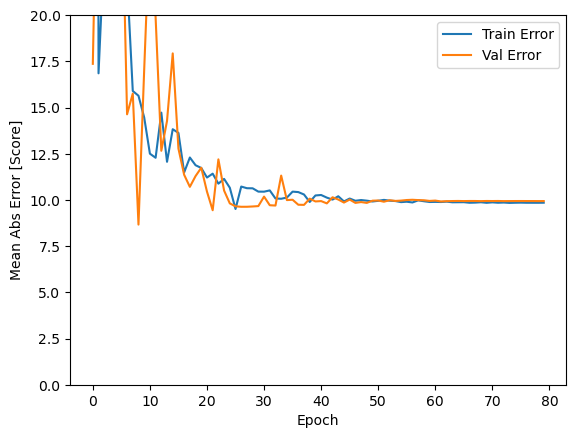

7.1.3. Model test evaluation
The test set and coefficient of determination were used to evaluate model performance. On the 9 samples in the test set, the model's average prediction error was 9.98. A scatter plot comparing model predictions and true values is shown below (see Figure 3).
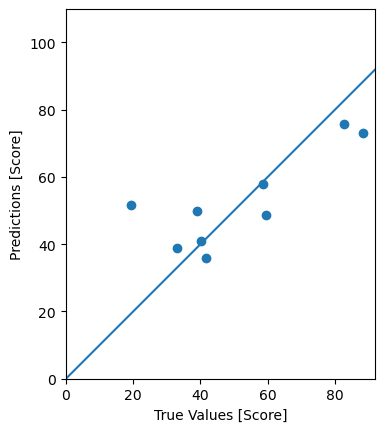
7.1.4. Coefficient of determination evaluation
Substituting the prediction data into the
7.2. Multiple linear regression model
After model training, the model. Predict (
Mean Squared Error: 6137.869861875643
Mean Absolute Error: 54.74593044769049
Coefficients:
0.21333172 Attention Process
2.32687236 Cognitive Representation Process
0.42033247 Behavior Generation Process
0.22584012 Motivation Process
1.11550035 Motivation
Intercept: 5.370304362681054

7.3. Grey relational analysis model
Data was read and preprocessed. The grey relational degree between each feature and the target feature was calculated. Features were ranked based on their grey relational degree, and the top features were selected as input features. The results are shown below (see Figure 5).
Grey Relation Scores:
Attention Process: 0.6319
Cognitive Representation Process: 0.6567
Behavior Generation Process: 0.6543
Motivation Process: 0.6663
Motivation: 0.6512
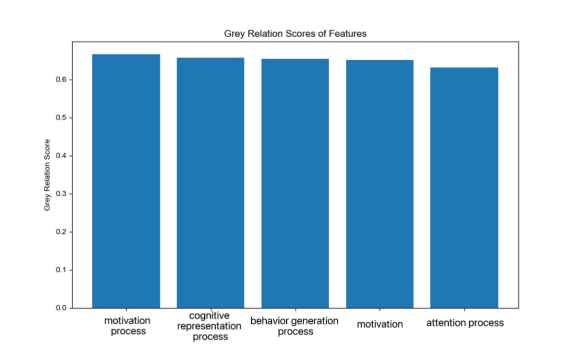
8. Model validation and analysis
8.1. Neural network model
The MSE and MAE charts show that the neural network's Mean Squared Error stabilized around 166, and the Mean Absolute Error stabilized around 9.8. The model had relatively many outliers. According to model evaluation tests, the coefficient of determination
8.2. Multiple linear regression model
Cognitive characteristics and social skills in autism typically involve multiple influencing factors. The multiple linear regression model allows for the simultaneous quantitative assessment of the impact of multiple independent variables on the dependent variable. This model is simple, easy to implement, and its results are highly interpretable, providing an intuitive reflection of the contribution of each cognitive characteristic to social skills. The sensitivity analysis (controlling variables) for each cognitive feature in the linear regression model is visualized below (see Figure 6). It is evident that the cognitive representation process has the highest sensitivity score, significantly higher than other factors. This indicates that the cognitive representation process has the greatest impact on the model output and is the most sensitive factor. motivation also has a relatively high sensitivity score, indicating it is also a significant influencing factor. Other factors (attention process, behavior generation process, motivation process) have lower sensitivity scores, suggesting their impact on the output is relatively minor. Therefore, these factors (Cognitive Representation and motivation) warrant primary focus in model optimization or decision-making. Based on the training results, the linear regression model performed poorly on the current dataset, evidenced by the low
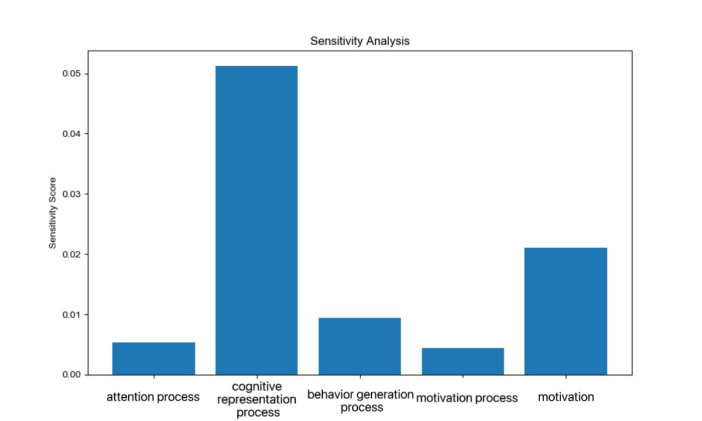
8.3. Grey relational analysis model
Grey relational analysis does not directly analyze sensitivity; it is used to identify and rank the main factors influencing the system. Due to the small data volume, the applicability and accuracy of all models are limited. No linear relationship between autistic cognitive characteristics and social skills was found; only associations were discovered, introducing uncertainty for formulating intervention measures. There is significant room for optimization.
9. Conclusion
This study, through in-depth analysis of the social cognitive characteristics and interpersonal skills of 73 autistic children, revealed varying degrees of influence of different cognitive characteristics on interpersonal skills. Results from the Grey Relational Analysis model showed that attention process, cognitive representation process, behavior generation process, motivation process, and motivation all exhibited a similar, moderate level of correlation with interpersonal skills. This suggests that improving the cognitive representation and behavioral motivation processes in autistic children may help enhance their interpersonal skills. Specifically, improving autistic children's ability to recognize errors and stimulating their interest in interacting with others could potentially boost their social abilities. Furthermore, although other social cognitive characteristics showed lower correlations with interpersonal skills, they might still have indirect effects on the children's social development. These findings provide an important basis for developing effective intervention strategies for autistic children in the future.
Despite yielding meaningful findings, this study has limitations. The current model's prediction accuracy needs improvement, evidenced by high MSE and MAE, and the failure to identify a linear relationship. These point towards limited predictive power. Based on the above findings, we propose the following recommendations and future research directions:
(1) Personalized Intervention Strategies: Develop personalized intervention programs targeting the key factors identified (attention process, cognitive representation process, behavior generation process, motivation process, motivation) to enhance the social cognitive abilities and interpersonal skills of autistic children.
(2) Multi-dimensional Assessment Models: Considering the limitations of existing models, future research should explore assessment models incorporating more variables and non-linear relationships to improve the accuracy of predicting interpersonal skills in autistic children.
(3) Longitudinal Tracking Studies: Conduct longitudinal studies to evaluate the long-term effectiveness of interventions and further understand the developmental trajectory of social skills in autistic children.
In conclusion, this study provides new perspectives and methods for understanding and assisting autistic children, demonstrating the influence of cognitive characteristics on social skill development and pointing towards potential directions for future research and practice. Through continued research and practice, we hope to create a more inclusive and supportive environment for autistic children, helping them maximize their personal potential.
References
[1]. Wucai Lu Autism Research Institute. (2017). Report on the Development Status of China's Autism Education and Rehabilitation Industry. http: //read.nlc.cn/yuewen/detail?id=1273387
[2]. Havdahl, A., Niarchou, M., Starnawska, A., Uddin, M., van der Merwe, C., & Warrier, V. (2021). Genetic contributions to autism spectrum disorder.Psychological medicine, 51(13), 2260-2273.
[3]. Wang, L., Wang, B., Wu, C., Wang, J., & Sun, M. (2023). Autism spectrum disorder: neurodevelopmental risk factors, biological mechanism, and precision therapy.International journal of molecular sciences, 24(3), 1819.
[4]. Hus, Y., & Segal, O. (2021). Challenges surrounding the diagnosis of autism in children. Neuropsychiatric disease and treatment, 3509-3529.
[5]. Elsabbagh, M., & Johnson, M. H. (2016). Autism and the social brain: The first-year puzzle.Biological psychiatry, 80(2), 94-99.
[6]. Green, L., Fein, D., Joy, S., & Waterhouse, L. (1995). Cognitive functioning in autism: An overview.Learning and cognition in autism, 13-31.
[7]. Posner, M. I., & Snyder, C. R. (2024). Attention and cognitive control 1. In Information processing and cognition (pp. 55-85). Routledge.
[8]. Johnson-Laird, P. N. (1980). Mental models in cognitive science.Cognitive science, 4(1), 71-115.
[9]. Itskovich, E., Zyga, O., Libove, R. A., Phillips, J. M., Garner, J. P., & Parker, K. J. (2021). Complex interplay between cognitive ability and social motivation in predicting social skill: A unique role for social motivation in children with autism.Autism Research, 14(1), 86-92.
[10]. Ismail, Z., McGirr, A., Gill, S., Hu, S., Forkert, N. D., & Smith, E. E. (2021). Mild behavioral impairment and subjective cognitive decline predict cognitive and functional decline.Journal of Alzheimer’s disease, 80(1), 459-469.
[11]. Spitzberg, B. H. (2003). Methods of interpersonal skill assessment. In Handbook of communication and social interaction skills (pp. 111-152). Routledge.
Cite this article
Zhang,Q. (2025). Mathematical modeling and intervention strategy analysis of social cognitive characteristics and interpersonal skills in children with autism. Advances in Social Behavior Research,16(5),1-11.
Data availability
The datasets used and/or analyzed during the current study will be available from the authors upon reasonable request.
Disclaimer/Publisher's Note
The statements, opinions and data contained in all publications are solely those of the individual author(s) and contributor(s) and not of EWA Publishing and/or the editor(s). EWA Publishing and/or the editor(s) disclaim responsibility for any injury to people or property resulting from any ideas, methods, instructions or products referred to in the content.
About volume
Journal:Advances in Social Behavior Research
© 2024 by the author(s). Licensee EWA Publishing, Oxford, UK. This article is an open access article distributed under the terms and
conditions of the Creative Commons Attribution (CC BY) license. Authors who
publish this series agree to the following terms:
1. Authors retain copyright and grant the series right of first publication with the work simultaneously licensed under a Creative Commons
Attribution License that allows others to share the work with an acknowledgment of the work's authorship and initial publication in this
series.
2. Authors are able to enter into separate, additional contractual arrangements for the non-exclusive distribution of the series's published
version of the work (e.g., post it to an institutional repository or publish it in a book), with an acknowledgment of its initial
publication in this series.
3. Authors are permitted and encouraged to post their work online (e.g., in institutional repositories or on their website) prior to and
during the submission process, as it can lead to productive exchanges, as well as earlier and greater citation of published work (See
Open access policy for details).
References
[1]. Wucai Lu Autism Research Institute. (2017). Report on the Development Status of China's Autism Education and Rehabilitation Industry. http: //read.nlc.cn/yuewen/detail?id=1273387
[2]. Havdahl, A., Niarchou, M., Starnawska, A., Uddin, M., van der Merwe, C., & Warrier, V. (2021). Genetic contributions to autism spectrum disorder.Psychological medicine, 51(13), 2260-2273.
[3]. Wang, L., Wang, B., Wu, C., Wang, J., & Sun, M. (2023). Autism spectrum disorder: neurodevelopmental risk factors, biological mechanism, and precision therapy.International journal of molecular sciences, 24(3), 1819.
[4]. Hus, Y., & Segal, O. (2021). Challenges surrounding the diagnosis of autism in children. Neuropsychiatric disease and treatment, 3509-3529.
[5]. Elsabbagh, M., & Johnson, M. H. (2016). Autism and the social brain: The first-year puzzle.Biological psychiatry, 80(2), 94-99.
[6]. Green, L., Fein, D., Joy, S., & Waterhouse, L. (1995). Cognitive functioning in autism: An overview.Learning and cognition in autism, 13-31.
[7]. Posner, M. I., & Snyder, C. R. (2024). Attention and cognitive control 1. In Information processing and cognition (pp. 55-85). Routledge.
[8]. Johnson-Laird, P. N. (1980). Mental models in cognitive science.Cognitive science, 4(1), 71-115.
[9]. Itskovich, E., Zyga, O., Libove, R. A., Phillips, J. M., Garner, J. P., & Parker, K. J. (2021). Complex interplay between cognitive ability and social motivation in predicting social skill: A unique role for social motivation in children with autism.Autism Research, 14(1), 86-92.
[10]. Ismail, Z., McGirr, A., Gill, S., Hu, S., Forkert, N. D., & Smith, E. E. (2021). Mild behavioral impairment and subjective cognitive decline predict cognitive and functional decline.Journal of Alzheimer’s disease, 80(1), 459-469.
[11]. Spitzberg, B. H. (2003). Methods of interpersonal skill assessment. In Handbook of communication and social interaction skills (pp. 111-152). Routledge.





